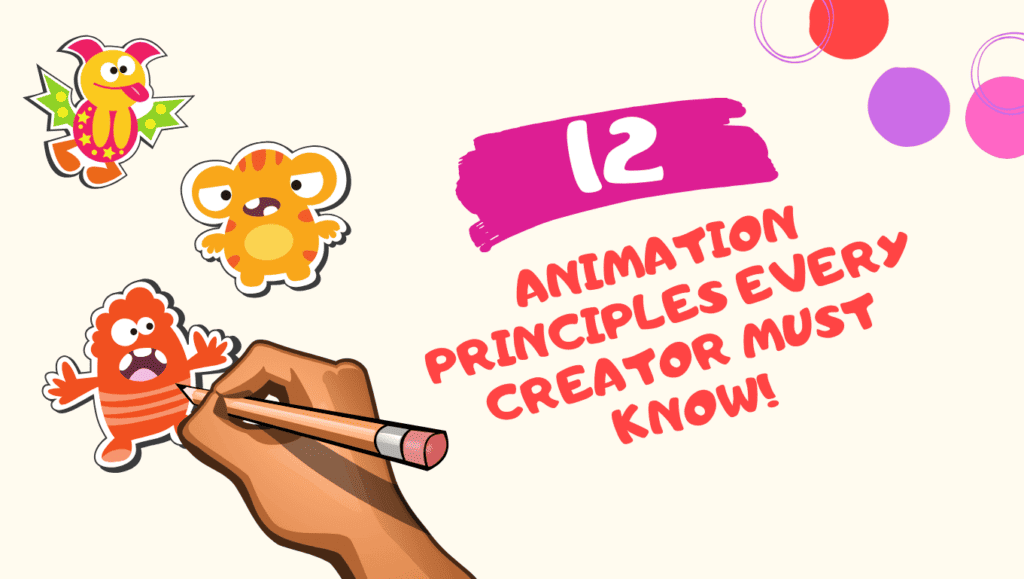Have you ever marveled at the seamless movements of animated characters on the screen and wondered how animators bring them to life?
Behind the magic of animation lies a set of fundamental principles that every creator must grasp to create compelling and realistic motion.
In this article, we’ll delve into the world of animation, exploring the 12 Principles of Animation that form the backbone of this captivating art form.
Whether you’re an aspiring animator, a seasoned professional, or simply a fan of animated content, understanding these principles is crucial to appreciating the skill and effort that goes into every frame.
Table of Contents
What are the 12 Principles of Animation? (A Brief History)
The 12 principles of animation were introduced for better animations. developed by Disney Animation are fundamental guidelines for creating more realistic and appealing 3d or 2d animations.
Before we explore each principle in detail, let’s take a trip back in time to understand the origins of Disney’s 12 principles of animation.
In the early 1930s, animators at Disney faced the challenge of creating more realistic and engaging characters. This led to the collaboration between two prominent Disney animators Ollie Johnston and Frank Thomas.
In 1981, they released the influential book “The Illusion of Life,” which detailed these fundamental principles.
These principles aren’t just a set of rules; they are a guide to breathing life into characters, making them feel more genuine and captivating.
Now, let’s delve into each principle, exploring its significance and providing examples that showcase their application.
Disney’s 12 Principles of Animation
1. Squash and Stretch
One of the most fundamental basic principles of animation, squash and stretch, gives characters a sense of weight and volume.
Imagine a bouncing ball – as it hits the ground, it squashes, and as it rebounds, it stretches. This principle is not only applicable to physical objects but also to characters.
When a character anticipates a jump, their body should squash before propelling upward, creating a more realistic and dynamic movement.
Example:
Think of a rubber ball dropped onto the ground. The way it deforms and then elongates upon bouncing is a perfect representation of squash and stretch.
Movie Example:
In Disney’s “The Jungle Book,” the character Baloo exemplifies squash and stretch as he bounces and dances to the rhythm of the music.
2. Anticipation
Anticipation is the art of preparing the audience for an action, making it more believable and engaging. It involves a brief movement in the opposite direction before the main action.
For instance, a character preparing to jump will first crouch down, adding a layer of realism to the movement.
Example:
Picture a character about to throw a punch. The slight backward movement of the hand before the punch is the anticipation, building tension before the actual action.
Movie Example:
In “Toy Story,” the character Woody often anticipates a movement by leaning back before making a sudden gesture. This principle enhances storytelling and ensures that actions feel grounded and deliberate.
3. Staging
Staging is about presenting an idea or a character clearly to the audience. It helps emphasise the main action. It ensures that the main action is easily understood and that secondary elements do not distract from the primary focus.
Effective staging guides the viewer’s attention, enhancing the overall impact of the animation.
Example:
In a scene where a character is running from a monster, staging would involve emphasizing the fear on the character’s face rather than intricate background details.
Movie Example:
In the movie “The Lion King,” during the iconic scene where Simba is presented to the animal kingdom, staging is crucial to showcasing the significance of the moment.
4. Straight Ahead Action and Pose to Pose
These are two different approaches to animating. Straight ahead action involves drawing frame by frame from start to end, creating a fluid and spontaneous animation.
On the other hand, pose to pose involves creating keyframes at significant points, with the remaining frames filled in later. Each approach has its benefits, and a skilled animator often uses a combination of both.
Example:
Imagine animating a character doing a complex dance routine. Straight-ahead action would capture the continuous flow of movement, while pose to pose could highlight key poses in the routine.
Movie Example:
In “Finding Nemo,” the scene where the fish navigate the strong current utilizes a combination of both animation techniques – action and pose-to-pose, to capture the fluidity of water movement.
5. Follow Through and Overlapping Action
Follow through and overlapping action refer to the continuation of movement after the main action is complete. These principles add realism and depth to animations, making them feel less robotic.
A character’s hair bouncing after a sudden stop or the trailing movement of a cape are examples of follow through and overlapping action.
Example:
When a character abruptly stops running, their hair and clothing continue to move forward briefly, demonstrating the follow-through principle.
Movie Example:
In “Zootopia,” the character Judy Hopps showcases follow through and overlapping action in her energetic movements, enhancing the believability of her actions.
6. Slow In and Slow Out
Movement in the real world is rarely constant; it accelerates and decelerates. This principle follows the laws of physics related to acceleration and deceleration.
Slow in and slow out imitates this natural movement by gradually increasing and decreasing the number of frames between poses. This principle is crucial for creating smooth and realistic animations.
Example:
Consider a character swinging a golf club. The wind-up and follow-through motions involve slow in and slow out, mimicking the natural flow of the action.
Movie Example:
In “The Incredibles,” the character “Dash” demonstrates this principle as he accelerates and decelerates during his super-speed runs.
7. Arcs
Arcs play a vital role in creating natural and fluid motion. The principle of arcs is based on the natural trajectory that objects follow in motion, adhering to the basic laws of physics that dictate the path of movement.
Most actions in life follow an arced trajectory rather than a straight line. Animating characters or objects to move along arcs enhances the sense of realism in your animations.
Example: When a character raises their arm, the movement should follow a curved path, resembling the natural motion of the human body.
Movie Example:
In “Moana,” the character’s movements in the dance sequences beautifully incorporate arcs, contributing to the fluidity of the animation.
8. Secondary Action
Adding secondary actions to your animations complements the main action, providing depth and complexity. These additional movements might not be the primary focus but contribute to the overall richness of the scene.
Example:
Imagine a character delivering an important monologue. While the main action is the speech, subtle facial expressions or hand gestures can serve as secondary actions, reinforcing the emotions conveyed.
Movie Example:
In “Coco,” when the character Miguel strums his guitar, the secondary action involves the movement of his fingers, contributing to the overall richness of the scene.
9. Timing
Timing is the backbone of animation, dictating the number of frames used for an action. It helps in establishing the speed, weight, and mood of a movement. Understanding timing is crucial for creating animations that resonate with the audience.
Example:
A fast, energetic character might have quicker movements, while a slow, lumbering giant would have deliberate and measured actions, showcasing the importance of timing in animation.
Movie Example:
In “Frozen,” during Elsa’s transformation sequence, the timing is crucial to convey the power and emotion of the moment.
10. Exaggeration
While realism is essential, exaggeration allows animators to emphasize actions and emotions. This principle involves pushing certain aspects of movement or expression beyond the boundaries of reality to create more memorable and entertaining animations.
Example:
If a character is surprised, exaggerating the size of their eyes and the height of their jump can convey the emotion more effectively.
Movie Example:
In “The Little Mermaid,” the villain Ursula’s exaggerated movements and expressions enhance her sinister and flamboyant personality.
11. Solid Drawing
In the realm of animation, characters and objects exist in a three-dimensional space. Solid drawing ensures that animators understand the volume, weight, and perspective of the elements they are animating, resulting in more convincing and immersive animations.
Example:
When animating a rotating object, solid drawing involves understanding how the object occupies space from different angles, maintaining its three-dimensional integrity.
Movie Example:
In “Beauty and the Beast,” the dance sequence between Belle and the Beast showcases solid drawing, making the characters feel more tangible and lifelike.
12. Appeal
The final principle, appeal, focuses on making characters interesting and captivating. It involves designing characters in a way that resonates with the audience, evoking emotions and keeping them invested in the animation.
Example:
Consider iconic animated characters like Mickey Mouse or Bugs Bunny. Their designs and personalities have broad appeal, making them timeless and beloved by audiences of all ages.
Movie Example:
In “Aladdin,” the character Genie’s appeal lies in his charismatic personality and dynamic animation, making him a memorable and beloved character.
11 Reasons Why The 12 Principles of Animation Are Important
The 12 Principles of Animation are crucial in the world of animation for several reasons:
1. Realism and Believability:
These principles help animators create more realistic and believable movements. The principles are based on observations of real-world physics and human behavior, allowing animations to feel more natural.
2. Expressiveness:
The principles enhance the expressiveness of characters and objects in animation. By understanding principles like exaggeration and squash and stretch, animators can convey emotions and actions more effectively.
3. Consistency:
The principles provide a consistent framework for animators to work within. This helps maintain a cohesive look and feel throughout an animation, ensuring that movements flow smoothly from one frame to the next.
4. Efficiency:
Animators use these principles to streamline their workflow. By applying well-established techniques, they can work more efficiently and produce high-quality animations in a more organized manner.
5. Storytelling:
Animation is a storytelling medium, and the principles play a crucial role in conveying narrative elements. Proper staging, timing, and secondary actions contribute to the overall storytelling experience.
6. Creativity:
While the principles provide a structure, they also encourage creativity. Animators can use them as a foundation to experiment, push boundaries, and develop their unique style.
7. Universal Language:
The principles act as a kind of universal language for animators. They provide a common set of guidelines that animators worldwide can understand and use, fostering a shared understanding within the animation community.
8. Foundation for Learning:
For individuals learning animation, the 12 Principles serve as a foundational framework. Beginners can build their skills step by step, starting with the basics and gradually incorporating more advanced principles as they progress.
9. Adaptability to Different Mediums:
While initially formulated for traditional hand-drawn animation, the principles are adaptable to various animation mediums, including modern animation, traditional animation, 3D animation, character design, computer animation, stop-motion, and more. They provide a versatile set of guidelines that can be applied across different techniques.
10. Audience Engagement:
Well-executed animation captivates audiences. The twelve principles contribute to creating animations that engage viewers emotionally and visually, making the storytelling experience more enjoyable and memorable.
11. Industry Standard:
The 12 Principles of Animation developed by Ollie Johnston and Frank Thomas have become an industry standard. Animators and animation studios around the world reference and incorporate these principles into their work, ensuring a level of consistency and professionalism within the field.
FAQs:
Do the 12 principles of animation apply to 3d?
Yes, the 12 Principles of Animation are applicable to 3D animation as well. While these principles were initially formulated with traditional hand-drawn animation in mind, they provide a foundational understanding of movement and storytelling that is fundamental to animation in general. Many of the principles can be directly translated to the 3D animation context, with some adjustments for the unique characteristics of three-dimensional space.
How is the animation principle of staging applied to a 3D scene?
In a 3D scene, the animation principle of staging is applied by strategically placing and framing important elements to guide the viewer’s focus, convey the narrative clearly, and create a visually compelling composition. This involves careful positioning of characters, props, and the camera to ensure that the audience understands the main idea of the scene and follows the intended story flow.
Conclusion: Mastering the Principles of Animation
In the vast and ever-evolving world of animation, these 12 principles of animation serve as a timeless guide for creators. Whether you’re involved in traditional 2D animation or cutting-edge 3D animation, these principles continue to be the bedrock of creating compelling and realistic movements.
As you embark on your animation journey, remember to apply these principles thoughtfully. Experiment with different combinations, understand the nuances of timing, and don’t shy away from adding your touch of creativity through exaggeration.
By mastering these principles, you’ll not only create visually stunning animations but also captivate your audience with characters that feel alive.
Key Takeaways:
- Follow Laws of Physics: Whether creating realistic movements or fantastical sequences, adherence to the laws of physics enhances believability.
- Master the Basics: Understand the 12 Principles of Animation as the foundational framework for your work.
- Squash and Stretch: Adds weight and volume to characters and objects.
- Anticipation: Prepares the audience for an action, making it more believable.
- Staging: Presents ideas or characters clearly, guiding the viewer’s attention.
- Straight Ahead Action and Pose to Pose: Two approaches to animating, each with its advantages.
- Follow Through and Overlapping Action: Adds realism by continuing movement after the main action.
- Slow In and Slow Out: Mimics the natural acceleration and deceleration of movements.
- Arcs: Followed for creating natural and fluid motion.
- Secondary Action: Enhances the main action by adding depth and complexity.
- Timing: Dictates the number of frames used for an action, influencing speed and mood.
- Exaggeration: Pushes aspects of movement or expression beyond reality for emphasis.
- Solid Drawing: Ensures a deep understanding of the three-dimensional space occupied by characters and objects.
- Appeal: Focuses on making characters interesting and captivating to the audience.
By applying these principles, you’ll be better equipped to create animations that captivate audiences and stand the test of time. As you continue to move in the animation world, remember that the illusion of life is in your hands, waiting to be animated frame by frame. Happy animation work!









